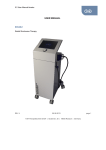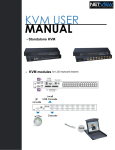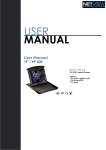Download Installation and Operation Manual
Transcript
Installation and Operation Manual PC-Power Uninterruptible Power Systems (UPS) PTM Series MAN 332 Issue 1 Installation and Operation Manual Important Safety Instructions • WHEN REPLACING BATTERIES, USE THE SAME QUANTITY AND TYPE OF BATTERIES: SEALED LEAD-ACID MAINTENANCE FREE: PTM280VA: 1 x 7AH/12V PTM420VA: 1 x 7AH/12V PTM650VA: 1 x 11AH/12V PTM1KVA: 3 x 11AH/6V • PROPER DISPOSAL OF BATTERIES IS REQUIRED. PLEASE REFER TO YOUR LOCAL CODES FOR DISPOSAL REQUIREMENTS. • THE UPS CONTAINS VOLTAGES WHICH ARE POTENTIALLY HAZARDOUS. ALL REPAIRS SHOULD BE PERFORMED BY QUALIFIED SERVICE PERSONNEL. • THE UPS HAS ITS OWN INTERNAL ENERGY SOURCE (BATTERY). THE OUTPUT RECEPTACLES MAY BE LIVE EVEN WHEN THE UPS IS NOT CONNECTED TO AN AC SUPPLY. For safe and continuous operation of the UPS depends partially on the care taken by users. Please observe the following precautions. • Do not disassemble the UPS. • Do not attempt to power the UPS from any supply, other than a 3-wire grounded source. • Do not place the UPS near water or in environments of excessive humidity. • Do not block the air vents on the side of the UPS. • Do not plug appliances, such as hair dryers, into the UPS sockets. • Do not place the UPS under direct sunshine or close to heat-emitting sources. • This UPS is intended for installation in a temperature controlled, indoor area free of conductive contaminants. MAN332%1.pm5 page 2 Installation and Operation Manual Index 1. Introduction 1.1 1.2 1.3 1.4 1.5 1.6 1.7 1.8 Overview .................................................................................................................... 4 Smart Buck and Boost Line Conditioning .................................................................. 4 User Replaceable Battery Design ............................................................................... 4 Advanced Computer Interface ................................................................................... 4 User Configurable Settings ......................................................................................... 4 SNMP Application Ready .......................................................................................... 5 Schedule Shutdown and Start-up ............................................................................... 5 Data-line Surge Protection ......................................................................................... 5 2. UPS Controls 2.1 2.2 2.3 2.4 2.5 2.6 External Views ........................................................................................................... 5 Front Panel Test/Silence Button ................................................................................. 6 Status Indication ......................................................................................................... 6 User Configurable Settings ......................................................................................... 7 Communication Port and Pin Assignments ................................................................ 7 Data-line Surge Suppression ...................................................................................... 8 3. Installation and Operation 3.1 3.2 3.3 3.4 3.5 3.6 Unpacking and Inspection .......................................................................................... 9 Placement ................................................................................................................... 9 Determining how much equipment you can connect to your UPS ............................. 9 Powering up and connecting your UPS .................................................................... 10 Operation and Functional Test ................................................................................. 11 Storage Instructions ................................................................................................. 11 4. User Replaceable Battery 4.1 4.2 4.3 Warning .................................................................................................................... 11 Battery Replacement Procedure for PTM280VA and PTM420VA ......................... 12 Battery Replacement Procedure for PTM650VA and PTM1KVA .......................... 12 5. Troubleshooting Guide ...................................................................... 13 MAN332%1.pm5 page 3 Installation and Operation Manual 1. Introduction 1.1 Overview PC-Power is an advanced line-interactive Uninterruptible Power System (UPS), designed to protect sensitive equipment, such items as computers, telecommunication systems, and computerized instruments, from spikes, surges, saps, transients and blackouts. When mains is present, the UPS filters small fluctuations continuously. When mains fails, the UPS uses its internal battery to supply back-up power. 1.2 Smart Buck and Boost Line Conditioning The standard European nominal mains voltage is 230V. The actual mains voltage can fluctuate above or below this nominal value. To protect sensitive loads from such mains fluctuations, the UPS provides line conditioning using both buck (step-down voltage) and boost (step-up voltage) functions. The line conditioning feature allows the UPS to provide protection over a wider mains voltage range without drawing power from its internal battery. 1.3 User Replaceable Battery Design The internal battery is the most critical component in the UPS. It has a design life of between 3-5 years. With a PC-Power UPS, the battery can be replaced by the user, even in hot mode. 1.4 Advanced Computer Interface PC-Power UPS provide complete RS232 and volt-free contact interfacing. Using the UPS monitoring and shutdown package, OptiSafe, a user can use a computer screen to determine the input/output voltage and current, frequency and battery voltage, etc, and analyse power problems. 1.5 User Configurable Settings The operating parameters of a PC-Power UPS can be adjusted to suit the characteristics of its site. MAN332%1.pm5 page 4 Installation and Operation Manual 1.6 SNMP Application Ready PC-Power UPS can support the Simple Network Management Protocol (SNMP). With a proper external adapter (such as a UPS SNMP adapter), a network manager can monitor any local or remote UPS from a Network Management Station (NMS). 1.7 Schedule Shutdown & Startup Using the OptiSafe software package, a PC-Power UPS can be locally or remotely controlled (turned on and off), using a weekly schedule to meet specific requirements. 1.8 Data-Line Surge Protection (PTM650VA and PTM1KVA) The built-in data-line surge suppression on the rear panel provides an easy way to protect a network (RJ45) or modem (RJ11) connection from hazardous spikes. 2. UPS Controls 2.1 External Views (Front and rear) Status Indication LEDs Test/Silence switch Status Indication LED Test/Silence switch Computer Interface Port Computer Interface Port Phone/Data Line Surge Suppression User configurable DIP switches Main switch Phone/Data Line Surge Suppression Main switch IEC320 Outlet Circuit Breaker IEC320 Inlet PTM280VA and PTM420VA MAN332%1.pm5 Circuit Breaker IEC320 Inlet IEC320 Outlets PTM650VA and PTM1KVA page 5 Installation and Operation Manual 2.2 Front Panel Test/Silence Button The Test/Silence Button has two functions: 1. If you press the Test/Silence Button when mains is available, the UPS tests itself by switching to its internal battery for a few seconds. We recommend you close all your open files before initiating this test. 2. If mains fails, the UPS warns you with an audible alarm. To silence the alarm, press the Test/Silence Button. The alarm returns, beeping faster, when the UPS battery is low. To silence the alarm again, press the Test/Silence button. 2.3 Status Indication PTM280VA and PTM420VA Front Panel LEDs: Front Panel LED Green Orange (flash every 4 seconds) Orange Orange Orange (flash once), then green Condition ac Mains present Battery discharging on mains failure Overload UPS fault condition Self test activated PTM650VA and PTM1KVA Front Panel LEDs: Front Panel LED Condition Boost Mode: The UPS is correcting a brownout condition. The UPS raises the output voltage by approximately 12% higher than the input voltage, without drawing internal battery power. Normal Mode: The UPS is in normal mode and is providing power to the load. The output voltage matches the input voltage and the UPS continues to filter and provide surge protection. Buck Mode: The UPS is correcting an overvoltage. The UPS lowers the output voltage by approximately 12% lower than the input voltage, without drawing internal battery power. Battery Mode: The UPS is providing battery from its internal battery. This LED also lights when the UPS is performing a self-test. Battery Weak: The battery voltage is low. This indicates that the battery needs either recharging or replacing. Overload: The UPS is being overloaded. The load must be reduced immediately. MAN332%1.pm5 page 6 Installation and Operation Manual 2.4 User configurable Settings You can configure the operating parameters of your UPS to meet your application or geographical requirements. For the PTM280VA and PTM420VA models, use the DIP switches on the rear panel. For the PTM650VA and PTM1KVA models, use the OptiSafe software package. Two of the adjustable parameters are low and high voltage transfer points. A transfer point is the predetermined voltage at which the UPS transfers to battery power. In a few locations, mains voltage may fluctuate widely, and the UPS may transfer to battery operation too often. As a result, the battery may not be at full capacity if there is a complete power failure. If this is the case, you may adjust the low and high voltage transfer points so that your battery capacity is not unnecessarily drained. The adjustable parameters for all models are: • Low Voltage Transfer Point: lowers the transfer point by 10V. • High Voltage Transfer Point: raises the transfer point by 10V. • Low Battery Warning Time: increases from two minutes to five minutes the low battery warning before shutdown. This adjustment is useful if your UPS is protecting a computer system that requires extra time to shut down. • Delay Audible Alarm in Backup Mode: disables the audible alarm during a power failure until the battery power is low. This adjustment is useful in areas in which the alarm may be annoying because of frequent short power interruptions. DIP Switch Settings (PTM280VA-420VA): Function Switch Up Low Transfer Point 10V lower High Transfer Point 10V higher Low Battery Alarm 5 minutes Delay Audible Alarm enabled Switch Down default default 2 minutes disabled 2.5 Communication Port and Pin Assignments The communication port on the back of the UPS allows connection to a host computer. Using the OptiSafe UPS monitoring and control package, important operating information from a PC-Power UPS can be viewed on a computer screen. OptiSafe also provides automatic system shutdown. Using OptiSafe, the following are some of the parameters that can be monitored: Reading Description Input Voltage The actual input voltage to the UPS when ac mains is present. Output Voltage The actual output voltage of the UPS. AC Frequency The actual frequency of the UPS. Battery Voltage The dc voltage of the UPS. Change Battery The battery is dead and needs to be replaced. Percent Load The percentage of UPS VA capacity being used. Temperature The actual temperature inside the UPS (650VA-1KVA) MAN332%1.pm5 page 7 Installation and Operation Manual PC-Power also supports UPS communication software which uses volt-free contact signals. This type of software normally provides: • • • Warning when mains fails. Orderly system shutdown. UPS switch off Note: The communication port connection is at the users discretion. If not connected, the UPS will warn of a mains failure by sounding its audible alarm. Pin Assignment: 4 5 9 PIN PIN PIN PIN PIN 1 2 3 4 5 PIN 6 PIN 7 PIN 8 PIN 9 3 8 2 7 1 6 Remote Turn-on (Models:PTM650VA-PTM1KVA). UPS simulates a relay closing between pin 2 and pin 4 when input mains fails. Not connected. Common for pin 2 and pin 5. UPS simulates a relay closing between pin 5 and pin 4 when the battery has less than 2 minutes backup time left. User sends a RS232 high level (5-15V) for 3 seconds. This signal will turn off the UPS until a satisfactory mains voltage is available. It can operate only if the UPS is in battery mode. This pin is also used as the RS232 received pin (RXD). Common for pin 6 and pin 9. Not connected. RS232 transmitter pin (TXD). Note: 1. Pin 2 and Pin 5 are open collector outputs which must be pulled up to a common referenced supply, switch rating: +40V, 0.15A non-inductive. 2. Pin 4 and pin 7 should only be connected to ground. 2.6 Data-Line Surge Suppression The date-line surge suppression on the rear panel provides an easy way to protect a network (RJ45) or modem (RJ11) connection from hazardous spikes. Connect a 10/Base-T network cable or telephone line into the OUT socket. MAN332%1.pm5 page 8 Installation and Operation Manual 3. Installation and Operation Before installation, please read and understand the following instructions. 3.1 Unpacking and Inspection Examine the packing carton for damage. Notify the carrier immediately if there is any damage. SAVE THE BOX 3.2 Placement 1. This unit is intended for indoor use only. Although your UPS is very rugged, its components are not sealed from the environment. 2. The UPS must be installed in a protected environment away from heat-emitting appliances such as a radiator. Do not install this product where excessive moisture is present. 3. The location should provide adequate air flow around the UPS with 50mm clearance on all sides for proper ventilation. 3.3 Determining How Much Equipment You Can Connect to Your UPS 1. Make a list of all equipment that requires protection. 2. Each piece of equipment has voltage and current (VA) ratings printed on the back label. Your equipment may have a voltage rating such as 88-264V. Since the standard voltage in the UK is 230V, you should use 230V in your calculations. 3. Multiply the voltage and current of each piece of equipment (VA requirements); for example, 230V x 1A=230VA. Add up the VA requirements for each device; for example, 230VA + 40VA = 270VA. 4. Make sure that your UPS has at least as much VA capacity as your equipment requires. Note: Normally 25% capacity reservation is recommended. MAN332%1.pm5 page 9 Installation and Operation Manual 3.4 Powering Up and connecting Your UPS 1. For 230V versions: connect the input mains lead of your computer equipment to the inlet of the UPS and the wall socket. Use the power lead supplied with the UPS to connect from the outlet of the UPS to your equipment. Switch on the computer equipment. 2. Power up the UPS by turning on the main switch on the rear panel. 3. We recommend that you charge the battery for six (6) hours before use. You may use the UPS immediately without charging the battery, but the battery charge may be less than 100%. The UPS recharges the battery automatically whenever AC power is available. Note: DO NOT PLUG LASER PRINTERS INTO THE UPS BECAUSE THEY TYPICALLY DRAW TOO MUCH POWER MAN332%1.pm5 page 10 Installation and Operation Manual 3.5 Operation and Functional Test 1. Turn on the UPS by setting the rear panel main switch into position 1 or on. On the PTM280VA and PTM420VA models, the UPS will beep and the front panel LED will light. On the PTM650VA and PTM1KVA models, the UPS will beep and the front panel Normal Mode LED will light. 2. The UPS may be overloaded if the following occurs: On the PTM280VA and PTM420VA models, the buzzer sounds continuously and the LED is a constant orange colour. On the PTM650VA and PTM1KVA models, the buzzer sounds continuously and the Overload LED lights. Unplug the least critical devices, such as a printer etc. to remove the overload condition Note: Backup all unsaved files before you perform the following functional test. 3. To test the backup function, you may unplug the mains lead from the UPS or simply press the Test/ Silence Button on the front panel. During this test, ensure that your equipment operates properly and without interruption. If you leave your UPS on continuously, it is a good idea to perform a backup function test at least once a month. The OptiSafe software can be configured to perform automatic periodic tests. If you unplug the mains lead, all models will beep once every 4 seconds. You can press the Test/ Silence Button to silence the alarm. In addition, on the PTM280VA and PTM420VA models, the LED will flash on and off. On the PTM650VA and PTM1KVA models, the Battery Mode LED will light. Plug the mains lead back in after a few seconds. If you press the Test/Silence Button, all models wlll beep twice. In addition, on the PTM280VA and PTM420VA models, the LED will flash twice. On the PTM650VA and PTM1KVA models, the Battery Mode LED will light. When the test is over, the Normal Mode LED will light. 3.6 Storage Instructions For extended storage in moderate climates, the battery should be charged for 12 hours every 3 months. Repeat this every 2 months in high temperature locations. For the PTM280VA and PTM420VA models, plug the mains lead into the wall socket and turn on the main power switch. For the PTM650VA and PTM1KVA models, plug in the mains lead. The main power switch does not need to be turned on. 4. User Replaceable Battery The batteries inside this UPS should last between 3 and 5 years. If you suspect that the batteries are weak, charge the UPS for at least six (6) hours and then test the UPS again. If the UPS still does not provide adequate backup time, follow the procedures below to replace the batteries. 4.1 Warning Please read the following cautions before replacing the batteries. • Except for the battery, the unit contains no user serviceable parts. Repairs should be performed only by factory trained service personnel. • A battery can generate an electrical shock and high short-circuit current. The following precautions should be observed when working on batteries. (1) Remove watches, rings, or metal objects. (2) Use tools with insulated handles. • Do not dispose of batteries in a fire. The batteries may explode. • Do not open or mutilate batteries. They contain an electrolyte which is toxic and harmful to the skin and eyes. MAN332%1.pm5 page 11 Installation and Operation Manual • When replacing batteries, use the same quantity and type of batteries: sealed Lead-Acid Maintenance Free (PTM280VA: one 7AH/12V), (PTM420VA: one 7AH/12V) (PTM650VA: one 11AH/12V), (PTM1KVA: three 11AH/6V) 4.2 Battery Replacement Procedure for PTM280VA and PTM420VA Changing the batteries in your UPS is a safe and easy procedure. Since the battery is isolated from the AC input you may leave your UPS and computer or other equipment on during the following procedure. Please note that if you choose to leave the UPS on when the battery is removed, it will not be able to power your equipment if a power failure occurs. 1. 2. 3. 4. 5. 6. 7. 8. 9. 10. Remove the two small screws from the bottom of the front panel. Gently slide the front panel off. Remove the battery retaining plate by loosening the four screws holding it in place. Gently pull out the battery to the UPS; try to avoid crossing the wires. Disconnect the two wires connecting the battery to the UPS; try to avoid crossing the wires. Connect the wires to the new battery (the red wire is +, the black wire is -) Push the new battery into place. Re-position the battery retaining plate and tighten the four screws. Slide the front panel back into place. Tighten the two small screws on the bottom of the front panel. 4.3 Battery Replacement Procedure for PTM650VA and PTM1KVA Changing the batteries in your UPS is a safe and easy procedure. Since the battery is isolated from the AC input you may leave your UPS and computer or other equipment on during the following procedure. Please note that if you choose to leave the UPS on when the battery is removed, it will not be able to power your equipment if a power failure occurs. 1. 2. 3. 4. 5. 6. 7. 8. 9. 10. Remove the two small screws from the bottom of the front panel. Gently slide the front panel off. Remove the battery retaining plate by loosening the six screws holding it in place. Gently pull out the battery by the tape attached to it. Disconnect the two wires connecting the battery to the UPS; try to avoid crossing the wires. Connect the wires to the new battery (the red wire is +, the black wire is-) Push the new battery into place. Re-position the battery retaining plate and tighten the six screws. Slide the front panel back into place. Tighten the two small screws on the bottom of the front panel MAN332%1.pm5 page 12 Installation and Operation Manual 5 Troubleshooting Guide Models PTM280VA/PTM420VA Models PTM650VA/PTM1KVA MAN332%1.pm5 page 13


























